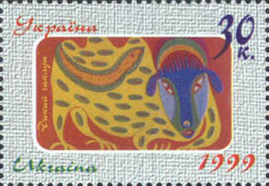by Amineddoleh & Associates LLC | Mar 1, 2022 |
During conflict, art and heritage is often the target of aggression or simply collateral damage. As discussed in our post from last Friday, art and cultural heritage in Ukraine continues to be at risk during Russia’s invasion.
Sadly, the destruction of art has been confirmed. According to a tweet from the Ministry of Foreign Affairs of Ukraine, one of the casualties from the attack on the Kyiv region was a collection of 25 paintings by notable Ukrainian artist, Maria Prymachenko. These works were stored in the Ivankiv Historical and Local History Museum which is located around 50 miles from Kyiv. While the destruction of the works has not been independently confirmed, several sources reported that the town in which the museum is located has been under fire. Further, satellite images show that the museum itself had been destroyed.

Ukrainian stamp featuring Maria Prymachenko’s art
Maria Prymachenko, who passed away in 1997 at the age of 88, was a self-taught artist best known for her colorful folk art. After seeing an exhibition of her work in Paris, Pablo Picasso stated, “I bow down before the artistic miracle of this brilliant Ukrainian.” The year 2009 was declared the Year of Maria Prymachenko by UNESCO. The Ministry of Foreign Affairs’ tweet highlighted Prymachenko for her “world-famous masterpieces” and “special gift and talent”. Her works have been honored by her home country, when they were featured on Ukrainian postage stamps. Ms. Prymachenko was also honored internationally, when UNESCO declared 2009 as the “Year of Maria Prymachenko.” Russia’s invasion has already caused significant destruction to several Ukrainian cities and one such casualty has been the museum and Prymachenko’s notable and priceless works.
Although not confirmed, social media reports that potentially looted Crimean artifacts have already appeared on the black market in the United Kingdom.
by Amineddoleh & Associates LLC | Jan 14, 2017 |
 The Art Newspaper recently reported that the long-held freeze on museum loans between Russian and U.S. museums could finally come to an end.
The Art Newspaper recently reported that the long-held freeze on museum loans between Russian and U.S. museums could finally come to an end.
In December, both the Senate and President Obama approved the Foreign Cultural Exchange Jurisdictional Immunity Clarification Act. The Act is intended to protect artworks and culturally significant objects on temporary loan to the United States from foreign institutions, by granting those artworks immunity from seizure.
Director of the State Hermitage Museum in St. Petersburg, Mikhail Piotrovsky, openly praised the Act to The Art Newspaper, noting that the law could potentially provide new assurances that Russian-owned artworks would not be subject to seizure while in the United States. Piotrovsky’s statements came while visiting his long-time friend President-elect Donald J. Trump at his Florida home in December. Trump himself has been very vocal about his intent to warm US-Russian relations, so the possibility of seeing Russian-owned artworks once again in the U.S. could become very real after his January inauguration.
The new law has nevertheless faced heavy criticism from groups including the Holocaust Art Restitution Project. Although objects subject to Nazi-era restitution claims are not afforded protection under the Act, critics point out that the new Act could extinguish valid restitution claims, such as claims against the Russian and Cuban governments.
The Russian government suspended all artwork loans to US museums in 2011, fearing that any loaned artwork could be seized as part of an outstanding court order requiring Russia to turn over a vast library of religious texts to the Chabad-Lubavitch Orthodox Jewish community. In 2010, a federal judge in Washington had ordered that the Russian government turn over the “Schneerson Library,” a collection of more than 70,000 religious texts and documents to the Chabad organization. The organization has been trying to regain possession of the library for years, which was seized by the Bolsheviks during World War II, and Russia has yet to return the documents. In response to Russia’s cancellation of museum loans to the United States, US museums have also frozen lending artworks to museums run by the Russian government.

